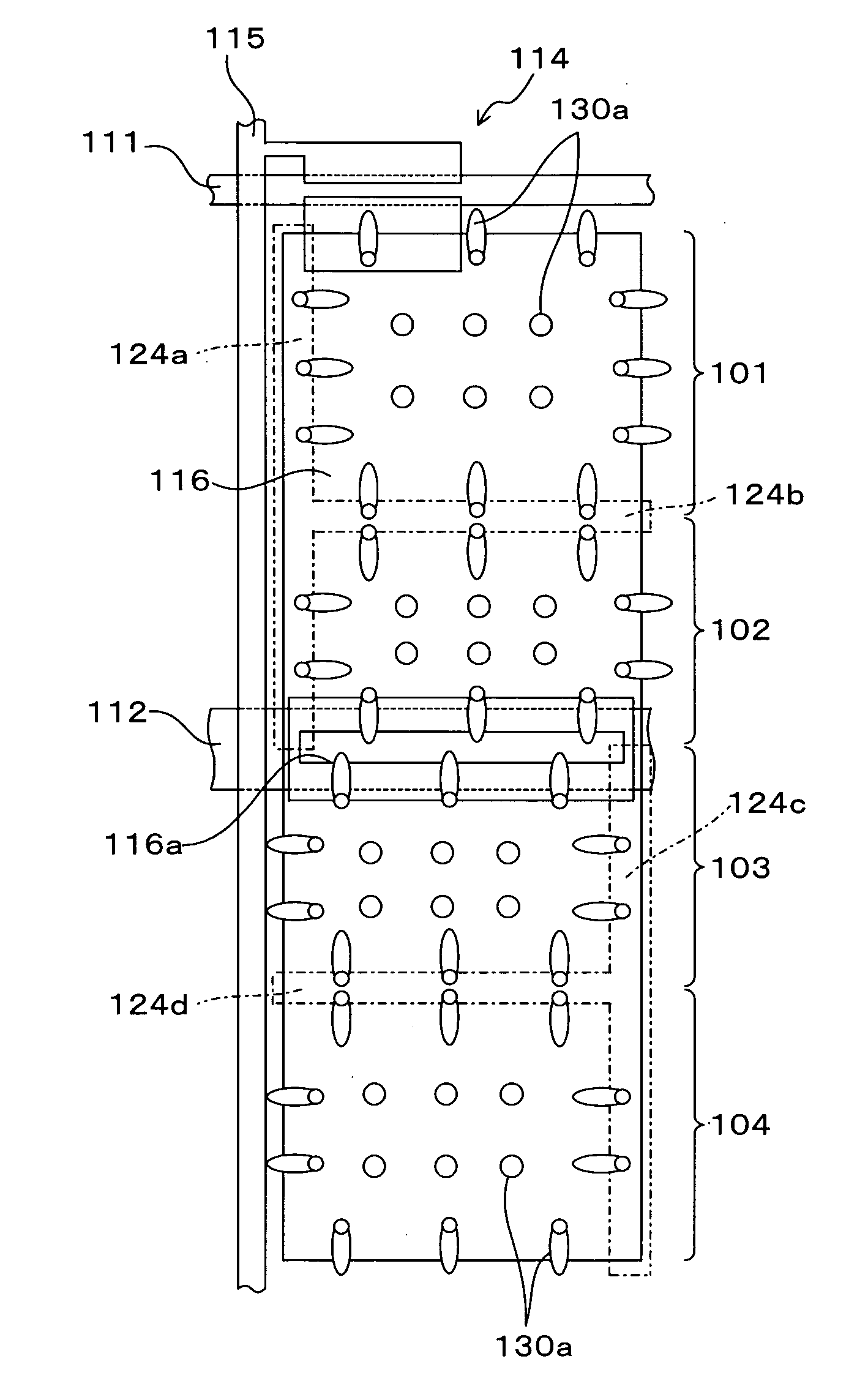Liquid crystal display device
- Summary
- Abstract
- Description
- Claims
- Application Information
AI Technical Summary
Benefits of technology
Problems solved by technology
Method used
Image
Examples
first embodiment
[0060]FIG. 2 is a plan view showing a liquid crystal display device of a first embodiment of the present invention. In this FIG. 2, two picture elements provided on a TFT substrate are shown. Further, in FIG. 3, a schematic cross section taken along the I-I line of FIG. 2 is shown. Note that numeric values in the following description are examples in the case of an XGA (1024×768 pixels) liquid crystal display device in which the panel size is 15 inches and in which the cell gap is 3.8 to 4.4 μm.
[0061] On the TFT substrate 110, a plurality of horizontally extending gate bus lines 111 and a plurality of vertically extending data bus lines 115 are formed. Each of the rectangular areas defined by the gate and data bus lines 111 and 115 is a picture element area. Further, on the TFT substrate 110, auxiliary capacitance bus lines 112, which are placed parallel to the gate bus lines 111 and cross the centers of the picture element areas, are formed. A first insulating film (not shown) is ...
second embodiment
[0096] Hereinafter, a second embodiment will be described.
[0097] In the first embodiment, it is considered that, as shown in FIG. 8, for example, in the first area 101, the liquid crystal molecules 130a in the middle portions of the protrusions 124a, 124b, and the like and the middle portions of the edges of the picture element electrodes 116 (regions surrounded by broken lines in the drawing) are tilted in directions shifted from 45°, because the force which tends to tilt the liquid crystal molecules 130a downward and the force which tends to tilt the liquid crystal molecules 130a leftward are not equivalent. In the case where the liquid crystal molecules 130a are aligned as in this FIG. 8, a region with low transmittance occurs in the middle portion of each side of the first area 101 as shown in FIG. 9. This tendency becomes more prominent as the lengths of the sides of the first area 101 become longer.
[0098] Accordingly, in the second embodiment, as shown in FIG. 10, slits (obl...
third embodiment
[0103]FIG. 11 is a plan view showing a liquid crystal display device of a third embodiment of the present invention. Incidentally, the third embodiment differs from the second embodiment in that the pattern of slits formed in picture element electrodes and the pattern of protrusions formed on a counter substrate differ from those of the second embodiment. Except for this, the configuration is basically the same as that of the second embodiment. Accordingly, in FIG. 11, the same components as those in FIG. 10 are denoted by the same reference numerals, and will not be further described in detail. Further, in FIG. 11, auxiliary capacitance bus lines and auxiliary capacitance electrodes are not shown.
[0104] In the present embodiment, a protrusion 124e is formed along the upper half of the left edge of each picture element electrode 116, and a protrusion 124f is formed along the lower half of the right edge of each picture element electrode 116. Further, a protrusion 124g is formed alo...
PUM
| Property | Measurement | Unit |
|---|---|---|
| Length | aaaaa | aaaaa |
| Length | aaaaa | aaaaa |
| Length | aaaaa | aaaaa |
Abstract
Description
Claims
Application Information
 Login to View More
Login to View More - R&D
- Intellectual Property
- Life Sciences
- Materials
- Tech Scout
- Unparalleled Data Quality
- Higher Quality Content
- 60% Fewer Hallucinations
Browse by: Latest US Patents, China's latest patents, Technical Efficacy Thesaurus, Application Domain, Technology Topic, Popular Technical Reports.
© 2025 PatSnap. All rights reserved.Legal|Privacy policy|Modern Slavery Act Transparency Statement|Sitemap|About US| Contact US: help@patsnap.com



